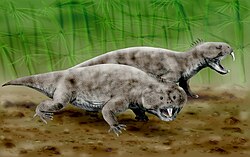Rhynchosaur
| Rhynchosaurs Temporal range: Olenekian–Norian |
|
|---|---|
 |
|
| life restoration of Hyperodapedon | |
| Scientific classification | |
| Kingdom: | Animalia |
| Phylum: | Chordata |
| Class: | Reptilia |
| Clade: | Archosauromorpha |
| Order: |
†Rhynchosauria Osborn, 1903 |
| Subgroups | |
Rhynchosaurs were a group of Triassic diapsid reptiles related to the archosaurs.
Rhynchosaurs were herbivores, and at times abundant (in some fossil localities accounting for 40 to 60% of specimens found), with stocky bodies and a powerful beak. Early primitive forms, like Mesosuchus and Howesia, were generally small and more typically lizard-like in build, and had skulls rather similar to the early diapsid Youngina, except for the beak and a few other features. Later and more advanced genera grew to medium to medium large size, up to two meters in length. The skull in these forms were short, broad, and triangular, becoming much wider than long in the most advanced forms like Hyperodapedon (= Scaphonyx), with a deep cheek region, and the premaxilla extending outwards and downwards to form the upper beak. The broad skull would have accommodated powerful jaw muscles. The lower jaw was also deep, and when the mouth was closed it clamped firmly into the maxilla (upper jaw), like the blade of a penknife closing into its handle. This scissors-like action would have enabled rhynchosaurs to cut up tough plant material.
The teeth were unusual; those in the maxilla and palate were modified into broad tooth plates. The hind feet were equipped with massive claws, presumably for digging up roots and tubers by backwards scratching of the hind limbs.
Like many animals of this time, they had a worldwide distribution, being found across Pangea. These abundant animals might have died out suddenly at the end of the Carnian (Middle of the Late Triassic period), perhaps as a result of the extinction of the Dicroidium flora on which they may have fed. On the other hand, Spielmann, Lucas and Hunt (2013) described three distal ends of humeri from early-mid Norian Bull Canyon Formation in New Mexico, which they interpreted as bones of rhynchosaurs belonging to the species Otischalkia elderae; thus, the fossils might indicate that rhynchosaurs survived until the Norian.
...
Wikipedia
